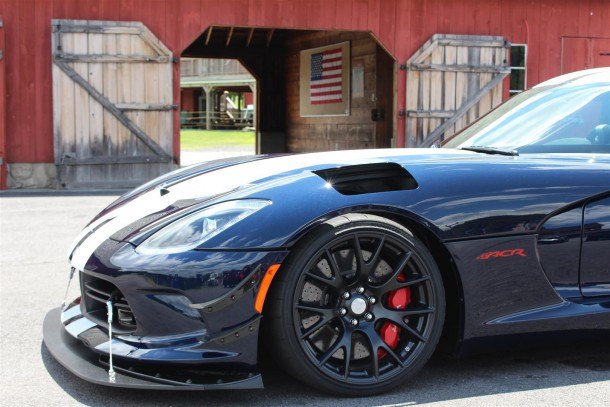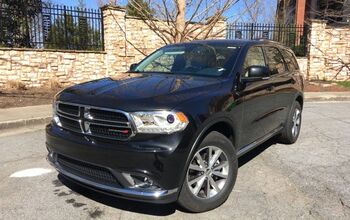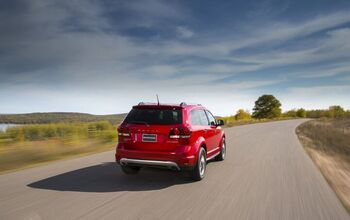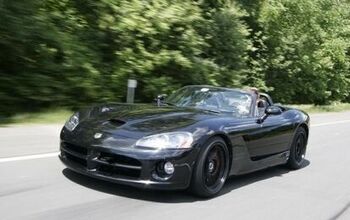2016 Dodge Viper ACR Review

You know what a Venn diagram is, right? It’s one of those drawings where you have two or more circles representing the members of different groups, and the area where the circles overlap shows common members of those groups. One of my favorite jokes goes like so: “The Venn diagram of people who care about font choice and people who care about food trucks is a single circle.”
Here’s another Venn diagram for you: the circle of people who have the talent and training to drive the new-for-2016 Viper ACR to its limits, and the circle of people who can afford the $117,500 plus-tax-and-title MSRP on the window sticker. How much overlap do you think there is between those circles?
Nominally speaking, this is the third performance variant of the current-generation Dodge (nee SRT) Viper, following on the heels of the Viper TA and the pylon-wing Viper TA 2.0. But that’s like calling Led Zeppelin “the last of the Yardbirds lineups with Jimmy Page.”
So how do you take a car that is already significantly faster around a track than pretty much everything else on the market and cut laptime further? Well, you could increase power, but Dodge didn’t bother to do it. The 8.4L V10 is already putting out 645 naturally-aspirated horsepower, delivered with the kind of brute force and persistence typically associated with 1300cc Suzuki sportbikes, as so the sole change to the motor is to fit low-restriction exhaust tips. No, the ACR isn’t a Z06 wannabe. Let’s see what you do get for your money.
Carbon-ceramic brakes, 390mm in the front, with six-piston calipers, both fitted to a Viper for the first time.
Bilstein shocks. The aluminum bodies cut 14 pounds from curb weight. The adjustable collars allow the car to have its ride height adjusted to just over four inches. It’s also possible to corner-balance the car for a particular driver, just like you do with real race cars. The damping is adjustable for both compression (how fast the shock absorbs pressure) and rebound (how fast it relaxes once the pressure’s off).
Kumho V720 tires. Designed from scratch to meet the needs of this car by the fellow who arguably invented the “DOT-R” concept of sticky race rubber with street-legal construction, these Kumhos are worth a couple seconds a lap all by themselves. SRT’s Erich Heuschele notes that they are designed to maintain a constant grip and heat dispersion over the course of multiple sessions. “Some of the competition has tires that drop off after a few laps,” Heuschele notes, before tactfully declining to comment on the Viper’s ability to maintain engine performance over a long track run without supercharger-induced “heat soak”. These tires are 200-treadwear and they can reportedly handle damp roads as well. Standing water? Better call your girlfriend and ask for a ride home. The front tires are an outrageous 25 aspect ratio so the Viper can use 19″ front wheels — all the better to clear the big brakes. Potholes should be avoided at all costs. At. All. Costs.
One of the rear diffusers, with replaceable rub strips because — you’re going to hit them on the track surface sometimes.
Removable fender vent, part of the Extreme Aero Package. Placement of American flag in background strictly on purpose.
Removable, adjustable front splitter, made of carbon fiber and reinforced with aluminum. Double “dive planes”, patiently wind-tunnel refined so you don’t lose as much front-end grip if the back end steps out a bit and changes the angle at which the planes meet the wind.
The full rear diffuser.
And that monstrous rear wing. The sum total of all the aero modifications, refined over hundreds of “CFD” iterations on a computer and hundreds of hours in a wind tunnel, is nearly one ton of downforce at the Viper’s top speed. Which drops from 206 mph to 177, courtesy of all of the wings and things. Think of the amount of wind pressure it takes to cut nearly 30 mph from a car’s speed. Now apply it on the tires. That will help you understand why this car can do what it does.
To counteract the weight of all that carbon fiber, the ACR goes on an interior diet as well.
The stereo loses nine of its twelve speakers. Interior trim panels in the cargo area are dispensed with. The quilted leather you’d get in a Viper GTS is replaced by Alcantara, and the power assistance for the seats disappears. Sound insulation? It’s gon-WHAT DID YOU SAY THEY DID WITH IT I CAN’T HEAR. Carpeting? Not much. But if, like me, you want a full helping of pimp juice in your track rat, you can restore every single interior appointment through the Viper “1 of 1” program. On the way to VIR, I drove a 1-of-1 with a full GTS interior, big-watt stereo, and TA 2.0 aerodynamics. Hell of a car. Like a Shelby Mustang with the interior of a Mark III.
The bare-bones ACR retails for $117,500 plus tax, title, and (can you believe it?) a gas-guzzler charge. That’s a lot of cash over and above the $84,995 you’d pay for a base Viper GT that will disappear into the distance should your ACR challenge one to any straight-line race lasting more than a few seconds. So what do you get for the money?
The below video won’t answer your question. It’s a 2:59 lap of the VIR Grand Course. Strictly speaking, that’s hauling the mail — but it’s really maybe fifteen seconds slower than what the car can do. To prevent anyone from pulling an Aaron Gold in one of just five pre-production ACRs available for the program, SRT gave us each some very nice instructors and asked us to leave some room on the track for mistakes. They also limited each drive session to just one full lap of the course. So what you see is your humble author trying to play by the rules.
Even at that relaxed pace, however, the ACR is simply the most brilliant street-legal car I’ve ever driven on a racetrack. Prior to this week, my benchmark for on-track behavior in a dead-stock supercar was set somewhere between the Viper TA 2.0 and the Ferrari 458 Speciale. (The McLaren 650S needs more front tire, in my not-so-humble opinion.) Compared to the ACR, the aforementioned cars might as well be base Mustangs.
To begin with, the ACR has all the good points of the current Viper. There’s enough room for me to swing my elbows a bit. The six-speed transmission has positive detents, reasonable throw length, and — oh yeah — it’s not some pansy-ass dual-clutch stockbroker special. Control efforts are heavy enough to communicate but not so much that it’s tiring to drive the car. Furthermore, the brakes, clutch, and steering all feel “organic”, not computer-controlled. The electronic stability control has a usable track setting and a usable sport setting and although it won’t babysit you the way Porsche’s PSM will, it can help you fix a mistake if you make one. Visibility is acceptable. Interior heat and airflow, the most miserable point of the original Viper GTS coupe and not entirely fixed in the last Viper to bear the ACR badge, is now okay if not outstanding.
I’ve said before that the Viper feels like a big Miata. You can trust it to do exactly what you ask, and then you need to be prepared for the consequences of your actions. The only worrying thing is that all of this happens at speeds much higher than what you can achieve in a Miata, so your margin for error is smaller. This ACR feels like a very big Radical. The aero grip is as real as a 747-800’s ability to leave the ground and it’s apparent in nearly every turn of the VIR Grand course layout.
Without getting too much into the details of shock/spring behavior (delightful, like smooth butter on top of a first-rate steak) or the frankly amazing ability of these Kumho tires to resist overheating, the best way to describe the ACR’s behavior on track is… cultured. It responds to the steering wheel in a way that only real race cars can. When it slides a bit, it gives you plenty of warning and all the time you need to fix the problem. It’s probably the least stressful supercar I’ve ever driven on a racetrack and it utterly outclasses the competition.
In the second half of the day, the SRT engineers gave me a small aero adjustment to the front and rear spoilers that balanced the car a bit more towards “neutral” behavior (neither understeer nor oversteer) and caused me to fall in love even farther. You can adjust your ACR any way you like in minutes, in the pit lane, and as you get used to a new track you can progressively sharpen the saw until you’re four-wheel sliding your way from every exit.
I took every lapping session I could in the ACR and got a total of five “hot laps” behind the wheel. It was far from enough. Oh, it was enough to see that the car is everything I’d wanted it to be, but it wasn’t enough to satisfy my explicit desires. I’d love to put a ten, fifty, two hundred laps on it in the course of a weekend. I can’t see getting tired of it. The beauty of the ACR is that it’s so capable and so transparent that it helps you learn more about your own abilities.
In a perfect world, these cars would be distributed the same way the aliens in “The Last Starfighter” chose their human champion: by finding the most talented drivers and making sure they each had one in the garage, along with a big stack of Kumhos to burn. In this world, it’s back to that Venn diagram and the vanishingly small group of people who can write the check and walk the walk. If you’re one of them, you shouldn’t hesitate.

More by Jack Baruth
Latest Car Reviews
Read moreLatest Product Reviews
Read moreRecent Comments
- Mgh57 I had to read the article because I had had no idea what the headline meant. I've never seen this in the Northeast. Don't understand the point. Doesn't seen efficient aerodynamically
- MaintenanceCosts Depends on the record of the company developing them. If it’s got a record of prioritizing safety over years of development, I’ll be fine with it, and I’ll expect it to be less risky than typical idiot human drivers. If it’s a “move fast and break sh!t” outfit like Tesla or Uber, no way.
- Kwik_Shift_Pro4X No thanks. You'll never convince me that anybody needs this.
- Kwik_Shift_Pro4X I'd rather do the driving.
- SCE to AUX EVs are a financial gamble for any mfr, but half-hearted commitment will guarantee losses.BTW, if there were actual, imminent government EV mandates, no mfr could make a statement about "listening to their customers".











































Comments
Join the conversation
I'd be perfectly happy with a plain old ordinary Viper. I've come to the point where I have more lust for a plain old Viper from 1992 to 2016 than an ordinary Vette from 1992 to 2016.
a GTS trim with the ACR CF applique = to a winner combo for me ;)